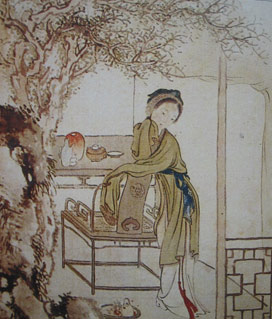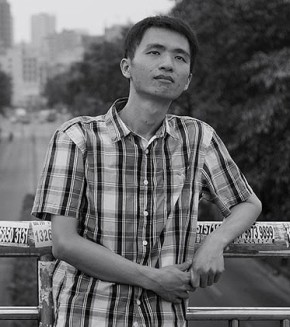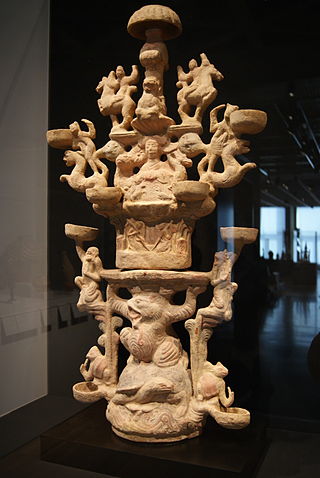
Wang Wei was a Chinese musician, painter, poet, and politician of the middle Tang dynasty. He is regarded as one of the most distinguished men of arts and letters of his era. About 400 of his poems survived and 29 of them are included in the 18th-century anthology Three Hundred Tang Poems. A large portion of his finest poems drew inspirations from the local landscape.

Chinese poetry is poetry written, spoken, or chanted in the Chinese language, and a part of the Chinese literature. While this last term comprises Classical Chinese, Standard Chinese, Mandarin Chinese, Yue Chinese, and other historical and vernacular forms of the language, its poetry generally falls into one of two primary types, Classical Chinese poetry and Modern Chinese poetry.

Dream of the Red Chamber or The Story of the Stone is a Chinese novel composed by Cao Xueqin in the mid-18th century. One of the Four Great Classical Novels of Chinese literature, it is known for its psychological scope and its observation of the worldview, aesthetics, lifestyles, and social relations of 18th-century China.

Meng Haoran was a major Tang dynasty poet, and a somewhat older contemporary of Wang Wei, Li Bai and Du Fu. Despite his brief pursuit of an official career, Meng Haoran mainly lived in and wrote about the area in which he was born and raised, in what is now Hubei province, China. Meng Haoran was a major influence on other contemporary and subsequent poets of the High Tang era because of his focus on nature as a main topic for poetry. Meng Haoran was also prominently featured in the Qing dynasty poetry anthology Three Hundred Tang Poems, having the fifth largest number of his poems included, for a total of fifteen, exceeded only by Du Fu, Li Bai, Wang Wei, and Li Shangyin. These poems of Meng Haoran were available in the English translations by Witter Bynner and Kiang Kanghu, by 1920, with the publication of The Jade Mountain. The Three Hundred Tang Poems also has two poems by Li Bai addressed to Meng Haoran, one in his praise and one written in farewell on the occasion of their parting company. Meng Haoran was also influential to Japanese poetry.

Yang Lian is a Swiss-Chinese poet associated with the Misty Poets and also with the Searching for Roots school. He was born in Bern, Switzerland, in 1955 and raised in Beijing, where he attended primary school.
Nationality words link to articles with information on the nation's poetry or literature.
The Three Hundred Tang Poems is an anthology of poems from the Chinese Tang dynasty (618–907). It was first compiled around 1763 by Sun Zhu (1722–1778), who was a Qing Dynasty scholar and was also known as Hengtang Tuishi. Various later editions also exist. All editions contain slightly more than 300 total poems. The number 300 was a classic number for a poetry collection due to the influence of the Classic of Poetry, which was generally known as The Three Hundred Poems.
Bloodaxe Books is a British publishing house specializing in poetry.

Stephen Romer, FRSL is an English poet, academic and literary critic.
Hualing Nieh Engle, née Nieh Hua-ling, is a Chinese novelist, fiction writer, and poet. She is a professor emerita at the University of Iowa.
Brian Holton is the translator of Chinese "Misty" poet Yang Lian. He translates into English and Scots, and is the only currently-publishing Chinese-Scots translator in the world.
Meng Jiao (751–814) was a Chinese poet during the Tang Dynasty. Two of his poems have been collected in the popular anthology Three Hundred Tang Poems. Meng was the oldest of the Mid-Tang poets and is noted for the unusual forcefulness and harshness of his poems.

Xu Lizhi was a Chinese poet and factory worker. Xu worked for Foxconn and attracted media attention after his suicide, after which his friends published his collection of poems.
Jintian is the title of a Chinese literary journal. Founded in 1978, it was the first non-official literary journal in the People's Republic of China since the 1950s. It ran for nine issues until it was censored in 1980. It was revived in 1990.
The Wellsweep Press was a UK-based independent publishing house, specialising in the publication of literary translation from Chinese. It was founded by poet and literary translator John Cayley in the 1980s, and published books from 1988 through the 1990s. It played a particularly important role in publishing contemporary and avant-garde Chinese literature in translation in the 1990s.
The Eight Pillars also known as Eight Pillars of the Sky are a concept from Chinese mythology. Located in the eight cardinal directions, they are a group of eight mountains or pillars which have been thought to hold up the sky. They are symbolically important as types of axis mundi and cosmology. Their functions in mythology ranged from pillars which functioned to hold apart the Earth and the Sky, as ladders allowing travel between the two, and as the location of various paradises or wonderland with associated magical people, plants, and animals. The Eight Pillars are a central aspect to Chinese mythology, and also have been used extensively in poetic allusion. Some variations exist, such as only having four pillars.
The Red River or Red Water is an important feature in the mythological geography of Chinese literature, including novels and poetry over a course of over two millennia from the Warring States to early Han dynasty era poetry of the Chuci onward. The Red River is one of the mythological rivers said to flow from Kunlun, a mythological land, with mountainous features. Translations into English include "Scarlet River".

The Moving Sands, also known as the Flowing Sands, is an important feature in the mythological geography of Chinese literature, including novels and poetry over a course of over two millennia from the Warring States to early Han dynasty era poetry of the Chuci onward to the present. In his poem "Li Sao", author Qu Yuan describes an aerial crossing of the Moving Sands on a shamanic spiritual Journey to Kunlun. "Moving Sands forms one of the obstacles the fictional version of the monk Xuanzang and companions must cross over on their mission to fetch the Buddhist scriptures from India and return them to Tang China. In this story, Xuanzang recruits the former sand demon and eater-of-humans Sha Wujing who is living in Moving Sands as his third disciple. Sometimes the Moving Sands seem to depict drifting dunes or desert, sometimes a sand or quicksand-like river, in which case, in Chinese, it would be (Liúshā-hé.








